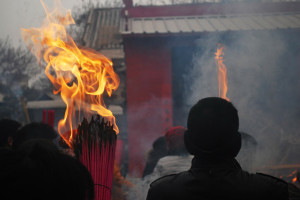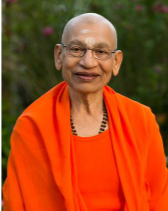
Spirituality

By Swami Viditātmānand Saraswati
In Gītā, Bhagavāna refers to karmayoga as yajña
Many devatās reside in our body. Sūrya devatā is in the eyes. Ātmadeva is in the heart. Digdevatā is in the ears etc. There are particular adhiṣṭhāna devatās of each of our jñānendriyas and karmendriyas who reside in our body as their part and perform different types of activities. What is the purpose of all the activities going on continuously by our jñānendriyas, karmendriyas and mind? Jñānendriyas continuously bring the gift in the form of jñāna from different viṣayas. Eyes bring the gift in the form of jñāna about different colors and forms, ears about jñāna of different words, sounds, music, and nose brings jñāna of different fragrances. This is a gift for the aṅtarātmā who resides in the center of the body. We do not see that ātmadeva, however, we can presume that ātmadeva exists based on the fact that all the devatās are bringing new gifts continuously. We do not see the mahātmā sitting in the āśrama. But, because devout devotees are gathered, all the devotees are entering the āśrama with gifts of flowers and fruits, we can presume that there should be some respectable, venerable mahātmā in the āśrama. Similarly, due to the activities of the indriyas, a presumption is made about paramātmadev residing in the body, and for that paramātmadev, a beautiful yajña is going on in our body. There is no need to go anywhere far to see the yajña.
A universal yajña is continually going on in the outer world also. Entire universe is as though the body of īśvara, earth is the feet of Bhagavāna, heaven is the head, air is prāṇa, sun and moon are the eyes, space is the middle part of the body. This is the cosmic svarūpa of īśvara. Earth, sun, moon etc. are the organs of His body. All these devatās in the form of organs are continuously working for īśvara with a huge svarūpa, offering different gifts to īśvara. In this manner, all the elements of the universe are worshipping īśvara. This is one view. There is a description of similar universal yajña in Muṅḍaka Upaniṣad also. In this yajña, there are five fires and five types of oblations are being offered because of which living beings are created. There is a yajña going on in heaven in which fuel is in the form of sun, and sun is given as oblation. And, with the cooperation of the sun and moon, clouds are formed. In the fire, in the form of clouds, oblation of saṁvatsara (time) is offered from which vegetation is produced. In the fire, in the form of a man, oblation of vegetation is given from which semen is produced. And at the end, semen is offered as oblation in the fire which is in the form of a woman, from which progeny is created.
In this chapter, Bhagavāna also says that animals are created from food and food is created from rain and rain is created from yajña:
अन्नाद्भवन्ति भूतानि पर्जन्यादन्नसम्भवः । यज्ञाद्भवनत पर्जन्यो यज्ञः कर्जसर्ुद्भवः ।।3.14।।
Animals are created from vegetation, vegetation is created because of rain, rain is formed from yajña and yajña is created from karma.
If food does not surrender itself, we do not get nourishment. If the food we have eaten is not digested in the stomach, we cannot live. Food entered into the stomach fully surrenders itself. Food is converted into nutrition and our body gets nourished. Also, the water of the rain surrenders itself and helps to absorb the nutrition and then only vegetation can be produced. Water forms when clouds surrender themselves and fall in the form of rain. Sun and moon are also doing yajña. Sun draws water from the ocean and other water bodies and converts it into steam. Moon cools the steam and that is how it rains. Therefore, all the elements in the universe are continuously performing yajña and only then the cycle of the universe is going on. And, animals are also born and nourished because of that.
Īśvara prevails in the universe in the form of yajña. Wherever we see, it seems that yajña is going on. In our body also, so many new cells keep getting created. Old cells are surrendered and new ones are born. Thus, due to surrender, the body is maintained. Therefore, Bhagavāna says that I am pervaded in this entire universe as yajña. Only I am performing yajña in the form of devatās and elements. In this manner, because of the nature of yajña, paramātmā is also called yajñapuruṣa.
Also read: Spiritual Discourses: The Confusion of Arjuna – 2
In this same chapter, drawing Arjuna’s attention Bhagavāna says, “O Pārtha, look, I am continuously performing yajña. There is nothing in these three lokas (worlds) that I do not possess because I am the ātmā of all. I do not have anything to gain, anything to prove and even then, without taking a break for a moment, I keep working. I am continuously managing the universe. In the form of devatās, in the form of the elements of the universe, I am sacrificing myself, only and only because of that, the universe is revolving and evolving. Not only in the form of īśvara but also in the form of Shri Krishna, I am continuously performing karma. If I am not busy performing karma selflessly, people will become inactive by following me. I do not have anything to lose by not doing anything and I do not have anything to gain by doing karma because I am complete myself, I am accomplished myself and therefore I am free in every way and even then, I am performing karma so that people can get an illustration.
In this manner, by His own example, Bhagavāna shows that there is no place of inaction. Not only that, whatever karma we perform by being active, that also should be done with an attitude of yajña, selflessly and with an attitude of offering.
यज्ञार्ाजत्कर्जणोऽन्यत्र लोकोऽयं कर्जबन्धिः ।3.9।।
Karma done with selfishness and motivated by narrow mindedness becomes binding. Karma performed with the attitude of yajña becomes a reason for purification of the mind; becomes a means for surrendering ahaṅkāra and mamakāra. Therefore, niyata karma means karma performed with the attitude of yajña and self-surrender.
When we analyze any person, when we try to understand that person, we will find that there are two elements in everyone: one element is puruṣa and another one is prakṛti. Puruṣa means the consciousness element that is ever pure, ever enlightened, free by nature. It resides in a purī (town) that is in the form of the body and therefore it is called puruṣa. Second element is prakṛti. Prakṛti is made of three guṇas: sattva, rajas, tamas. Pāpa and puṇya, virtues and vices, all these come under prakṛti. When one’s mind or prakṛti is sātvika, he is virtuous. When one’s mind is primarily occupied by rajoguṇa, he has restlessness, activity, greed, pride, ego etc. and when there is predominance of tamoguṇa in one, he has hatred, jealousy, anger, violence, cruelty etc. Thus, cruelty, greed, delusion, virtues, selfishness, selflessness, all of this is in prakṛti. The sinfulness of the one who we call sinner is a guṇa (attribute) of his prakṛti. And the virtuousness or the saintliness of a person is also in his prakṛti. Every animal has different prakṛti because the constitution of the guṇa in each animal is different. However, the puruṣa residing in this prakṛti everywhere is one only. Prakṛti is a role of puruṣa. If we only give reality to prakṛti, only look at the role, positive or negative reactions arise. In reality, the puruṣa wearing the costume of prakṛti is satya (real). If we make a note of that, the mind will remain free of such reactions. By worshiping such omniscient īśvara with his karma, one achieves purification of antaḥkaraṇa (mind).
Thus, Bhagavāna showed a solution of purifying antaḥkaraṇa, continuous service of īśvara, Nārāyaṇa, residing in all the roles. That Nārāyaṇa only is present in different forms in front of me. Therefore, any small or big karma that I perform with an attitude of offering it to Nārāyaṇa is called karmayoga. In Gītā, Bhagavāna refers to karmayoga as yajña. Bhagavāna is saying that all the elements in the universe are performing yajña. The paṅca mahābhūta (Pṛthvī (earth), jaḻa (water), agni (fire), vāyu (air), ākāśa (space)) and sun, moon, constellations in the form of universe are serving īśvara. For whom air blows, water flows, sun illumines, trees give fruits? Trees never eat their own fruits. Trees give fruits for serving others, water flows to serve others and sun also illuminates others. In this manner, except for human beings, if we see elsewhere, we realize that there is a universal yajña going on in the world. All the elements in the universe are dedicating themselves into this yajña. All the elements are dedicated to īśvara.
There is a maṅtra in Kaṭhopaniṣada:
ऊर्ध्वं प्राणर्ुन्नयत्यपािं प्रत्यगस्यनत ।
र्ध्येवार्िर्ासीिं नवश्वेदेवा उपासते॥
All the devas worship the venerable Vāmanadeva that is in the middle and who takes the prāṇa upward and pushes apāna downward. (Kaṭhopaniṣada 2-3)
Vāmanadeva, paramātmā resides in each body. While being there, he takes the prāṇa upward and pushes apāna downward. Meaning, He is continuously operating our inhalation-exhalation process because of which we can stay alive, our karmendriya, jñānendriya become capable to do their functions and our life remains in order. In the middle of the body, in the heart, paramātmā resides because of whom all the processes of the body are going on and devatās are worshipping this paramātmā.
*Swami Viditatmananda Saraswati has been teaching Vedānta Prasthānatrayī and Prakaraṇagranthas for last 40 years in Ahmedabad, Gujarat. Throughout the year, he conducts daily Vedānta discourses, accompanied by retreats, and Jñāna Yajñas on Vedānta in different cities in India and in foreign countries.





